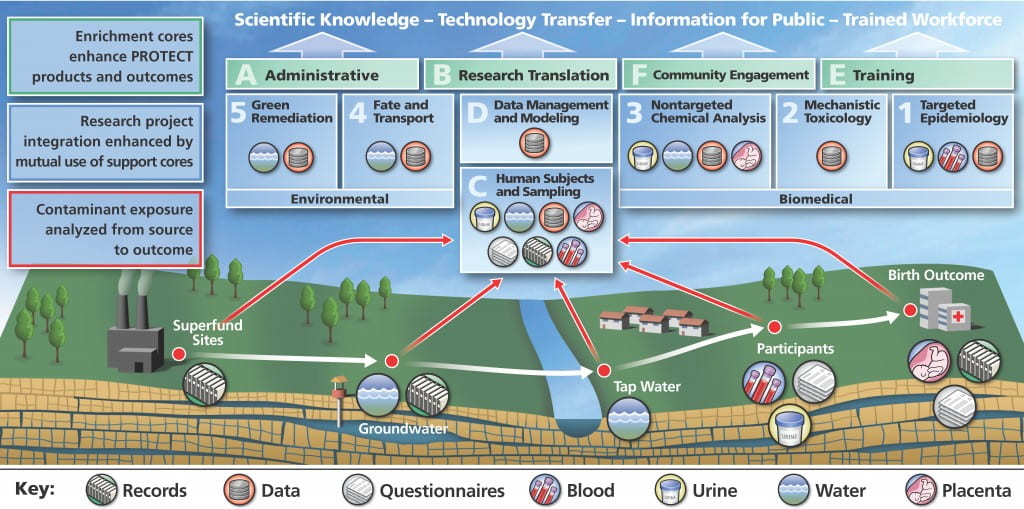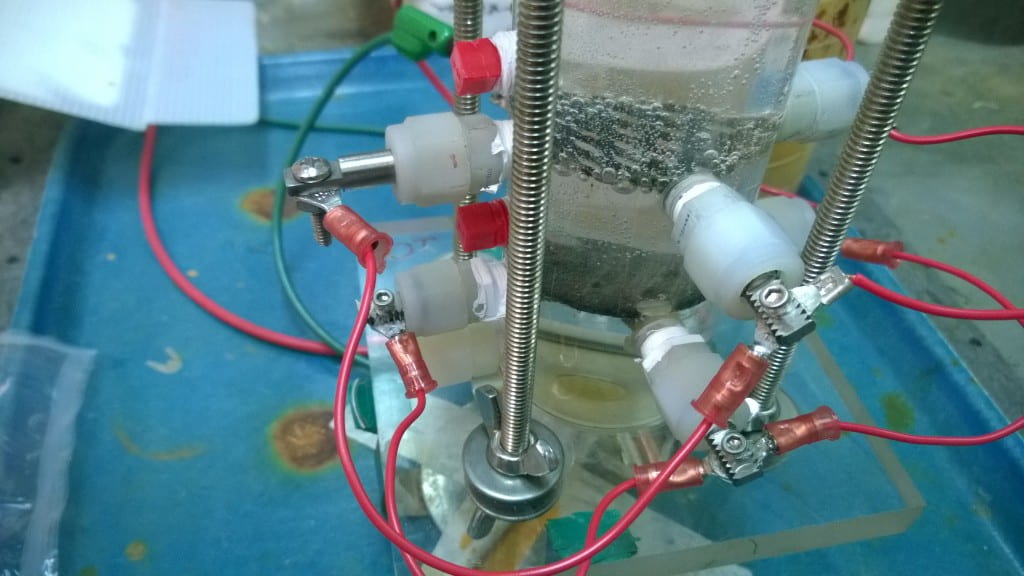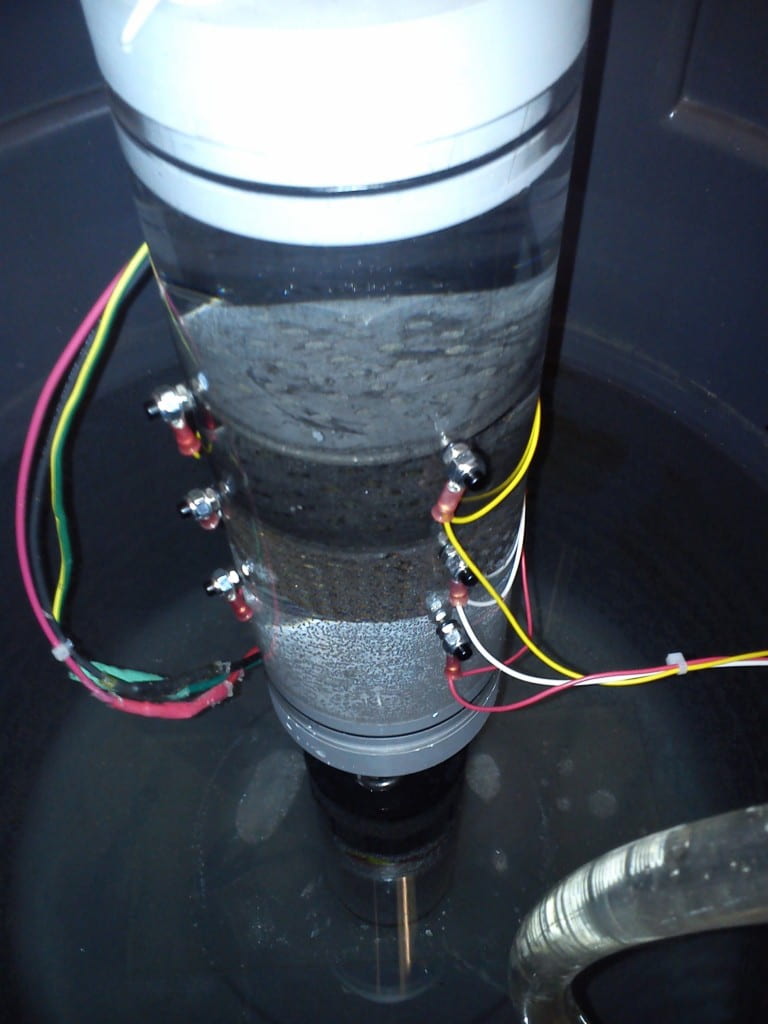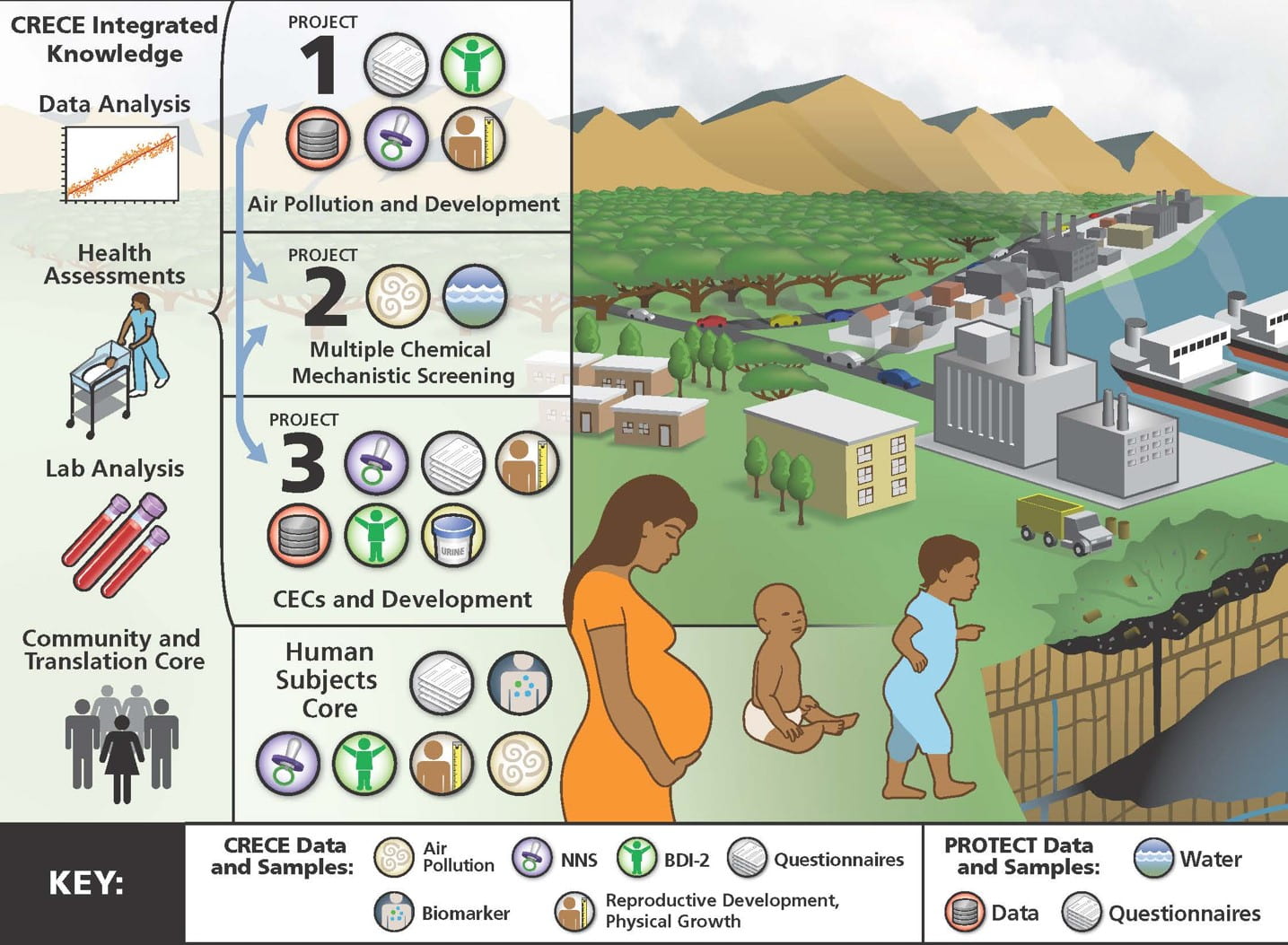The Puerto Rico Test site for Exploring Contamination Threats (PROTECT) Center
Supported with funding from the National Institute of Environmental Health Sciences’ Superfund Research Program, The PROTECT P42 Research Center investigates exposure to environmental contamination in Puerto Rico and its contribution to adverse reproductive outcomes, specifically preterm birth (less than 37 completed weeks of gestation). Through integrated analytical, mechanistic, epidemiology, fate-transport, and remediation studies, along with a centralized, indexed data repository, the PROTECT Center is focused on delivering new knowledge and technology in the area of contaminants of interest to the Superfund Research Program as a potential cause of preterm birth. The new knowledge and technology will also be useful more broadly in the overall field of environmental health. Puerto Rico has been selected as a test site because it has the highest rate of preterm birth (~20%) among the states and territories of the U.S., and because of the extent of hazardous waste contamination on the island. The PROTECT Center is a multi-project, multi-institution collaboration that involves four primary institutions: Northeastern University, University of Puerto Rico, Medical Sciences Campus, University of Puerto Rico, Mayaguez, and University of Michigan. The PROTECT Center is multidisciplinary and interdisciplinary and involves significant interaction and sharing of samples, testing, and results among the disciplines of analytical chemistry, epidemiology, engineering, and toxicology.

Solar-Powered Remediation of Contaminated Groundwater is Project 5 of the PROTECT Center. Our long-term goal is to develop green remediation based on the conversion of solar power into electrolysis in groundwater. Electrolysis will cause the transformation of contaminants in groundwater into non-toxic products without adverse effects on the environment. The technology can be implemented in sandy aquifers and is also suited for karst aquifers because the dynamic flow conditions in channels and fractures require controlled rates of electrolysis. The project demonstrates the transformation of trichloroethylene (TCE) and other contaminants (e.g., semi-polar organics such as phthalates), develops a predictive tool “model” for transformation, evaluates the effect of electrolysis on groundwater geochemistry and the physical properties of the aquifer and assesses the cytotoxicity of treated water.

Conceptual Design of Proposed Green Remediation Strategy
Improving transformation of mixtures of contaminants in groundwater
Team Members: Prof. Akram Alshawabkeh, Ljiljana Rajic (Associate Research Scientist), Noushin Fallahpour (Ph.D. Student), Roya Nazari (Ph.D. Student)
We measure the simultaneous transformation of TCE and a mixture of contaminants (e.g., chromium, selenate, nitrate and arsenic) by electrochemically-induced reduction and oxidation in groundwater. Chemical transformation is dependent on the ratio of flow rate to the electric current. Our system couples iron anode and a high surface area cathode (Cu foam) to remove all dissolved TCE from simulated groundwater while improving transformation of other contaminants including dichromate, selenate, and arsenite . A batch and flow-through undivided electrochemical systems are developed to support the electrochemically-induced oxidation (Electro- Fenton Reaction) of TCE . By a novel two electrode system with polarity reversal and optimized electrode arrangement with the use of proper cathode materials we improve both electrochemical reduction and oxidation to remove TCE from groundwater. Further, we will investigate the performance of the technology in the presence of naturally occurring substances (e.g. humic substances, chlorides) and ability to degrade other commonly found groundwater contaminants and species (di-2-ethylhexyl phthalate or DEHP, nitrates etc.) along with TCE.

Electrochemical Setup
Evaluating electrolytic remediation effects on groundwater toxicity
Team Members: Prof. April Gu (Lead Investigator), Man Hu (PhD student), Mokhlesur Rahman (PhD student)
In addition to the monitoring of reduction of parent contaminant compound, measurements of intermediates and their toxicity are essential to ensure complete degradation and elimination of toxicity. To assess the influence of our treatment technologies on the groundwater toxicity we work closely with Prof. April Gu’s group who developed a novel 3-D (genes, altered magnitude and time) toxicogenomics-based toxicity assessment method that allows low-cost, fast and high-throughput, yet informative and mechanistic toxicity evaluation of water samples.

Designing and implementing field-scale testing
Team Members: Prof. Akram Alshawabkeh, Prof. Ingrid Padilla (University of Puerto Rico at Mayaguez), Prof. Dorothy Vesper (West Virginia University), Ljiljana Rajic (Associate Research Scientist), Noushin Fallahpour (PhD Student), Roya Nazari (PhD Student)
The PROTECT Center focuses on the north coast limestone aquifer of Puerto Rico. This is a highly productive drinking water resource, but it is also highly threatened by Superfund sites contamination. The aquifer is in a karst region and, like other karst aquifers, is characterized by highly variable flow conditions: groundwater flow is stable during periods with little recharge (baseflow conditions) but responds heavily to recharge events (storm flow conditions).
We are working on design of the electrochemical reactor and improving its performance on the pilot-scale.

Developing models of groundwater flow, contaminants transport, and remediation processes in karst aquifers
Team Members: Prof. Akram Alshawabkeh, Prof. Ingrid Padilla (University of Puerto Rico at Mayaguez), Prof. Dorothy Vesper (West Virginia University), Xue Yu (Postdoctoral Fellow), Reza Ghasemisadeh (Ph.D. Student), Harshi Weerasinghe, PhD (PhD Student), Shirin Hojabri (PhD Student)
In collaboration with Project 4 (on contaminant fate and transport) and Core D (Data Management and Modeling), stochastic models are developed to simulate groundwater behavior considering spatial variability and uncertainty in hydrogeologic parameters. We use deterministic models to study the spatial and temporal changes in groundwater levels, and to evaluate the fate and transport of contaminants in karst aquifers. Furthermore, the fate and transport of contaminants in surface water resources is studied using complete hydrologic cycle model. Fine resolution spatial and temporal scale data are used to analyze dynamics of the flows in surface water resources connected with karst aquifers and the behavior of contaminants in such scenarios. By using data mining techniques and statistical analysis methods, we investigate spatiotemporal variability in subsurface hydrodynamics (e.g. fractal scaling behavior) and hydrogeochemistry (e.g. patterns of CVOCs). Socio-demographic profiles of water usage are studied to examine water consumption patterns and water sustainability in Puerto Rico. The research also focuses on modeling the chemical reactions in the electrochemical treatment process of contaminants; including the influence of different chemicals and parameters existence in the model, as different species and situations can alter the result and the rate of a chemical reaction. Developed models would predict in situ electrochemical remediation processes of TCE in groundwater for the specific sites.

Selected Publications:
Rajic L, Fallahpour N, Alshawabkeh AN. Impact of electrode sequence on electrochemical removal of trichloroethylene from aqueous solution, Appl. Catal., B. 2015; 174-175: pp 427-434. doi: 10.1016/j.apcatb.2015.03.018
Yuan S, Liao P, Alshawabkeh AN. Electrolytic Manipulation of Persulfate Reactivity by Iron Electrodes for TCE Degradation in Groundwater. Environ. Sci. Technol. 2014:48(1) pp 656-63.
Rajic L, Fallahpour N, Yuan S, Alshawabkeh AN. Electrochemical transformation of trichloroethylene in aqueous solution by electrode polarity reversal. Water Res. 2014:Sep (27C) pp 267-275.
Yuan S, Chen M, Mao X, Alshawabkeh AN. A Three-electrode Column for Pd-Catalytic Oxidation of TCE in Groundwater with Automatic pH-regulation and Resistance to Reduced Sulfur Compound Foiling. Water Res. Jan 2013:47(1) pp 269-78.
Yuan S, Chen M, Mao X, Alshawabkeh AN. Effects of Reduced Sulfur Compounds on Pd-catalytic Hydrodechlorination of TCE in Groundwater by Cathodic H2 under Electrochemically-induced Oxidizing Conditions. Environ. Sci. Technol. 2013:47(18) pp 10502–10509.
Yuan S, Gou N, Alshawabkeh AN, Gu AZ. (2013) Efficient degradation of contaminants of emerging concerns by a new electro-Fenton process with Ti/MMO cathode. Chemosphere. 2013:93(11) pp. 2796–2804.
Ciblak A, Mao X, Padilla I, Vesper D, Alshawabkeh ID, Alshawabkeh AN. Electrode effects on temporal changes in pH and redox potential in electrolytes for water treatment. Environmental Science and Health Part A. 2012:47( 5) pp 718-726.
Mao X, Ciblak A, Baek K, Amiri M, Loch-Caruso R, Alshawabkeh AN. Optimization of electrochemical dechlorination of trichloroethylene in reducing electrolytes. Water Res. 2012:46(6) pp 1847–1857.
Mao X, Yuan S, Fallahpour N, Ciblak A, Howard J, Padilla I, Loch-Caruso R, Alshawabkeh AN. Electrochemically induced dual reactive barriers for transformation of TCE and mixture of contaminants in groundwater. Environ Sci. Technol. 2012:6;46(21) pp 12003-11.
Gou N, Yuan S, Lan J, Gao C, Alshawabkeh AN, Gu AZ. A quantitative toxicogenomics assay reveals the evolution and nature of toxicity during the transformation of environmental pollutants. Environ Sci Technol. 2014:48(15) pp 8855-8863.
Gou N, Onnis-Hayden A and Gu AZ. Mechanistic Toxicity Assessment of Nanomaterials by Whole-Cell-Array Stress Genes Expression Analysis. Environ. Sci. Technol. 2010:44(15) pp 5964–5970.
Ghasemizadeh R, Hellweger F, Butscher C, Padilla I, Vesper D, Field M, Alshawabkeh AN. Review: Groundwater flow and transport modeling of karst aquifers, with particular reference to the North Coast limestone aquifer system of Puerto Rico. Hydrogeology Journal 2012:20(8) pp 1441-1461.
Yu X, Ghasemizadeh R, Padilla I, Meeker JD, Cordero JF, Alshawabkeh AN, Sociodemographic patterns of household water-use costs in Puerto Rico, Sci. Total Environ., 2015, 524-535: pp 300-309. doi:10.1016/j.scitotenv.2015.04.043
The Center for Research on Early Childhood Exposure and Development (CRECE, Spanish for “grow”) is a Children’s Environmental Health Center program directed by the U.S. Environmental Protection Agency and the National Institute of Environmental Health Sciences. CRECE studies how mixtures of environmental exposures and other factors affect the health and development of infants and children living in the heavily-contaminated island of Puerto Rico – an underserved, highly-exposed, and low-income population with significant health disparities.
CRECE recognizes that it is not just one exposure, but many exposures including air quality, water quality, consumer product use, psychosocial dynamics, and internal factors that can combine to create adverse health effects during infancy and childhood, with long-term impacts on adult health.

As a multi-project, multi-institution collaboration (including Northeastern University, University of Puerto Rico, Medical Sciences Campus, University of Georgia and University of Michigan), CRECE has been designed to tackle the conceptual, epidemiological and methodological challenges that mixture studies require by conducting a multifactorial exposure investigation in an existing birth cohort in Puerto Rico called PROTECT. Using a holistic source-to-outcome strategy that captures the totality of the environment known as the “exposome”, CRECE integrates analytical, mechanistic, epidemiology, psychosocial, toxicogenomic and air quality data to deliver new knowledge in the area of contaminants of interest and their effects on childhood growth and development. As part of its mission to be a vital and informative children’s environmental health resource for stakeholders, CRECE will also provide environmental health knowledge, education, and capacity building for researchers, cohort participants, the broader underserved Puerto Rican community, and beyond.
Research Opportunities for Undergraduates: Training in Environmental Health Science (ROUTES)
The “Research Opportunities for Undergraduates: Training in Environmental Health Science” (ROUTES) program is developed to increase the number of undergraduate underrepresented minority (URM) students participating in environmental health (EH) research, training them in interdisciplinary settings and continuing onto graduate studies and lifelong EH research careers. Given that minority populations are disproportionately burdened by exposures to environmental contamination, ROUTES addresses an urgent need to increase awareness and participation of underrepresented groups in EH research. ROUTES engages and prepares URM students for EH research careers through hands-on research experience, research community engagement, training, mentoring, and support. Program is bringing together the combined educational and experiential resources of Northeastern University faculty (with associated research centers and institutes), who provides their teaching, mentoring, and research expertise in environmental health sciences, including that in environmental engineering, environmental epidemiology, exposure sciences, and environmental chemistry and biology. Program will create a new educational program for URM students that transcends disciplinary knowledge in environmental health sciences.
Induced Partial Saturation (IPS) through Transport and Reactivity for Liquefaction Mitigation (PI: Yegian)
Mitigation of liquefaction-induced damage to the built environment continues to be an important priority and a major challenge in civil engineering. This project advances the IPS as a liquefaction mitigation measure to be considered by the professional engineering community in practice. The goal of the project include evaluating the fundamental factors affecting the process of IPS in sand by chemicals injection under field conditions, demonstrating the effectiveness of IPS in preventing the occurrence of liquefaction. The proposed research takes advantage of the unique experimental and field facilities of the NSF George E. Brown, Jr. Network for Earthquake Engineering Simulation (NEES) to acquire fundamental knowledge on the behavior of IPS in sands and to develop enabling technologies to verify the effectiveness of IPS as a liquefaction mitigation measure. This is a collaborative effort and the research team is composed of experts in the geotechnical earthquake engineering and liquefaction, and the geoenvironmental field. The program includes small-scale laboratory tests and numerical simulations at Northeastern University, tests using NEES@Buffalo’s large laminar box, preliminary field tests at Northeastern University and at Boise State University (utilizing their drilling rig and equipment), and field research and verification of the effect of IPS on liquefaction using NEES@UTexas T-Rex at the NEES@UCSB Wildlife Refuge. One of the tasks that our group is leading is evaluating, testing and simulating transport and reactivity of a low concentration of sodium percarbonate solution in sand, rates of oxygen gas formation and associated changes in saturation and hydraulic conductivity. The Project is led by Professor Yegian (PI) and is sponsored by NSF NEES Program award #1134940.